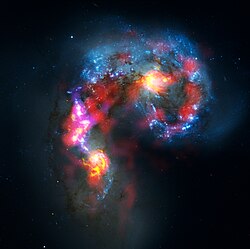Portal:Radiation astronomy/Resource/30
Submillimeters
[edit | edit source]
Submillimetre astronomy or submillimeter astronomy is the branch of observational astronomy that is conducted at submillimetre wavelengths of the electromagnetic spectrum. Astronomers place the submillimetre waveband between the far-infrared and microwave wavebands, typically taken to be between a few hundred micrometres and a millimetre." and "Using submillimetre observations, astronomers examine molecular clouds and dark cloud cores with a goal of clarifying the process of star formation from earliest collapse to stellar birth.
These wavelengths are sometimes called Terahertz radiation, since they have frequencies of the order of 1 THz.
"The Antennae Galaxies (also known as NGC 4038 and 4039) are a pair of distorted colliding spiral galaxies about 70 million light-years away, in the constellation of Corvus (The Crow). This view combines ALMA observations, made in two different wavelength ranges during the observatory’s early testing phase, with visible-light observations from the NASA/ESA Hubble Space Telescope."[1]
"The Hubble image is the sharpest view of this object ever taken and serves as the ultimate benchmark in terms of resolution. ALMA observes at much longer wavelengths which makes it much harder to obtain comparably sharp images. However, when the full ALMA array is completed its vision will be up to ten times sharper than Hubble."[1]
References
[edit | edit source]- ↑ 1.0 1.1 eso1137a (October 3, 2011). Antennae Galaxies composite of ALMA and Hubble observations. Parana, Chile: European Southern Observatory. http://www.eso.org/public/images/eso1137a/. Retrieved 2014-03-13.
